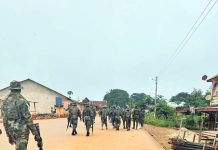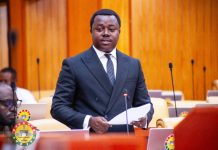The only female standing trial for treason and abetment with nine males, Warrant Officer Class 2 (WOII) Esther Saan Dekuwine, says the soft spoken voice in audio that seeks to incriminate her and the others, cannot be hers.
According to her, there was no video evidence backing the claim that she made certain pronouncements in the said audio. Esther is being accused of being the person who spoke with a soft voice in the said audio, recorded by a military personnel, urging that President Akufo-Addo should be killed.
WOII Esther Dekuwine, who is the sixth accused (A6) in the trial, argued that there were males whose voices sound like a female, and that merely hearing what seems like a female’s voice and attributing same to her was incorrect.
A6 made the assertion at the court, presided over by three justices – Afia Serwaa Asare-Botwe, Hafisata Amaleboba and George Oppong – when her counsel, Lemtiig Apanga, was cross-examining the sixth prosecution witness (PW6), Isaac Osei, who is a Spanish Lecturer at the Ghana Institute of Languages.
Mr Apanga challenged the witness that he was not a voice expert, therefore, cannot identify or have knowledge of persons speaking in the audio.
When the defence counsel asked: “Do you know people can mimic other people’s voices,” the witness responded, “You are saying so.”
Mr Apanga contended that the witness’ conclusion that a voice in the audio, labelled June 22, 2018, was a female voice, was his conjuncture and not something that he and his team had verified. But, Mr Osei answered that the he and his team did the transcription and translation to the best of their ability.
On that score, Mr Apanga further inquired, “You didn’t see the video of the audio in order to identify the particular female you claimed spoke,” to which the witness said he did not see the person who spoke in the audio.
The defence counsel also told the court that the transcription and interpretation of the audios, reportedly recorded by Staff Sergeant Awarf Sulley, do not reflect the evidence before the court, hence, they were not reliable.
For instance, Mr Apanga said, the translation “y3y3 Ghanafo de3, y3nyinaa nim nea 3koso, 3ny3 saa anaa?” but was translated as “We are Ghanaians.”
Thus, the PW6 concurred that something was missing from the translation, but argued that one omission should not affect the entire work he had done with his team.
The counsel disagreed and said the Lecturer was given a specific assignment, and it was his duty to transcribe exactly what was contained in the audio and video.
The following are excerpts of the cross-examination:
Q: Did you personally watch or listen to all videos you claimed to have transcribed?
A: No, because it was team work and they were assigned to individual members of the team. I did mine, and others did theirs. I’m confident about what my colleagues did was faithful to the task.
Q: There are some videos and audio you have not watched?
A: No, I have not watched all.
Q: You placed your signature on each transcript, as reflecting the content of each audio and video placed before the court?
A: Yes, because, being the Coordinator, I take the responsibility of work done by my colleagues.
Q: You are not in a position to verify the certainty of the content of the video and audio, as transcribed, without listening and watching?
A: It was a team work, and all were competent to the task assigned to them.
Q: You relied on your belief of the competence of your colleagues?
A: Yes, and also to the extent that I know their competence; they have been working on similar jobs for a long time…
Q: Team made up of three, including a lady?
A: No.
Q: Is it that each recording reflected a particular meeting held on a particular day?
A: The videos and audios were given to us already labeled, and we transcribed based on the number in a particular folder with a number labelled on it. For example, September 17, 2019 video, there were series of videos.
Q: On what materials were the video and audio contained?
A: On external hard drive and pen drive. So we copied on laptops and transcribed.
Q: How many people recorded the videos and audios?
A: I won’t be able to tell. When we finished the first session, Awarf, who the CID say did the recording, came and identified some of the persons involved.
Q: It is said that Awarf did the recording?
A: I can’t tell. We were told that he recorded some and came to identify some of those in it.
Q: Did anyone else assist in identifying the voices in the audios?
A: No.
Q: Did you notice during your supervision that some videos and audios were duplicated?
A: I can’t recollect.
Q: Take a look at Exhibits F and F1, first page of F1 and page 3 of F. Please read the beginning of F1 to the court.
A: Please, you are all welcome sirs, thank you. What we are about to start is nothing new…
Q: …You will agree that the texts in both are the same, as that of F begins with a phone ringing?
A: I am not able to talk about the content, my task was to transcribe, and that’s what I did.
Q: Be kind to tell court that their contents are practically the same?
A: I will not be able to say that. My work was to transcribe. I can’t tell what it meant or not.
Q: Exhibit F2, what is it? Describe it?
A: Transcription of final video July 18.
Q: Does that suggest that the content described was recorded on July 18, 2018?
A: I have reiterated that they were given to us labeled, so we transcribed and gave the same labels to them.
Q: Is the venue of the meeting described in the video you watched?
A: No, but we were to transcribe what we saw.
Q: Sir, in 00:01:36 of the exhibit described as final video, there was no indication that it was recorded at the beach -July 8, 2018. It is your own insertion?
A: We understood the scene to be beach, because of the wind.
Q: Does the wind blow at the car park?
A: I can’t tell, unless you tell me.
Q: Take a look at Page 5 of Exhibit A. Your description of F2 is that it was taken at the beach, is that based on what you were told?
A: No.
Q: Take a look at F2. I should use my own credit to call you, what for and F1.
A: Reading “…”
Q: Both exhibits contain the same words as you have read?
A: You are saying so. Any video and audio given was transcribed. I can’t say that they are same.
Q: What you read, is there any difference?
A: I’m unable to comment on the content. My job was to transcribe, and I am done.
Q: The contents are practically the same…?
A: I am unable to tell.
Q: Read the first page of Exhibit F?
A: I am becoming an azaa secretary.
Q: What’s the meaning of azaa in Ghana?
A: Crocked. It is a typographical error, it should be crook.
Q: Take a look at Page 2 of Exhibit 2. What is written there?
A: Even…
Q: In what language are they? What does it mean?
A: Pigin English. It is not clear. The meaning is not clear.
Q: Were those words translated into English?
A: No. We didn’t understand that Pigin.
Q: Are you an expert in Pigin English?
A: I can’t claim to be.
Q: Ghanaians speculate that it is Pigin. You are merely speculating; you don’t know the meaning?
A: You are saying.
Q: You were engaged to transcribe and translate, but you failed to translate all?
A: We did the work to the best of our ability and knowledge.
Q: Your ability was limited, that was why you were unable?
A: No, that’s not so. We translated volumes and volumes of work.
Q: In Ghanaian parlance when one says me Turkey aba, what does it say?
A: I can’t tell, it should be said in a context.
Q: The word Turkey means desire and not opportunity, as used in Exhibit F?
A: We got the meanings from the content.
Q: Do you speak Hausa or any of team members?
A: I don’t, but some of my team members, yes.
Q: What were the words spoken in Hausa?
A: As indicated, part of the conversation was inaudible, so the experts who understood helped us to get the meanings.
Q: The person who assisted you in identifying that Hausa was spoken didn’t tell you what was spoken?
A: The conversation was in Twi and Hausa, and that is what had been rendered there.
Q: Is it what happened? What was spoken in the two languages is what has been rendered?
A: Yes.









